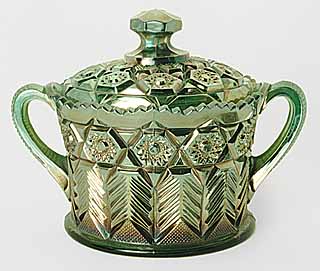Cambridge Iridescent Glass
by Bud Walker
Issue No. 296 - December 1997
Most glass collectors either love or hate the opalescent glass that was the answer to Lewis Comfort Tiffany's iridescent glass that was so popular during the 1920s. This new type of glass enabled the working class to afford glass that looked much like that being made at the Tiffany Studio. By now, many of you realize that I'm referring to the glass we now know as Carnival glass.
Carnival glass was first produced by the Fenton Glass Company in the
early 1900s. In talking to Mr. Frank Fenton, he told me the story of
how the Fenton glass company supposedly learned to make carnival glass.
As the story goes, when workers opened a boxcar filled with straw that
was used for packing glass, they found a drifter or itinerant asleep in
 the straw. After waking him up, he was asked what he was doing there.
His reply was that he was waiting to see the owners or plant manager as
he possessed a new method of decorating glass that would revolutionize
the glass industry. No one knows for sure if this story is true or not,
but, we do know that Fenton produced the first opalescent glass. Water
Lily and Cattails was the first pattern done in carnival by the Fenton
Company.
the straw. After waking him up, he was asked what he was doing there.
His reply was that he was waiting to see the owners or plant manager as
he possessed a new method of decorating glass that would revolutionize
the glass industry. No one knows for sure if this story is true or not,
but, we do know that Fenton produced the first opalescent glass. Water
Lily and Cattails was the first pattern done in carnival by the Fenton
Company.
When you ask most carnival glass collectors who the second company to produce carnival glass was, you will often hear the name Northwood. This company made some of the most beautiful carnival glass ever made. But they were not the second company. The second company was the Cambridge Glass Company. They were making carnival in 1908, about a year after Fenton first introduced it to the marketplace. Where and how A.J. Bennett learned the secret of iridescent glass has been lost to time. Some of the carnival pieces produced by Cambridge were Inverted Feather (picture at right), Inverted Strawberry, Thistle, and Marjorie which is known as Sweetheart. Buzz Saw, which carnival collectors know at Double Star, is another pattern that was made in carnival. Some pieces of Cambridge carnival will have the Near Cut trademark, but many of the early pieces were not marked. The colors produced by Cambridge are Marigold on Crystal glass, Green on Emerald glass, Blue on Royal Blue glass, Purple on Mulberry which is an Amethyst color glass. All carnival pieces made by Cambridge are hard to find, and collectors are willing to pay a premium for the pieces that come on the market. Of all the colors, Royal Blue is the rarest.
We may never know the reason Cambridge discontinued making carnival glass. One could guess that it was not a big seller, and A.J. decided to move on to something else. This certainly wasn't the case for Fenton, Northwood, Millersburg, and Imperial. They produced carnival glass in large quantities. This unique glass was produced in such large quantities that the bottom fell out of the market, and much of it ended up being given away as prizes at carnivals. This is how it came to be called carnival glass.
